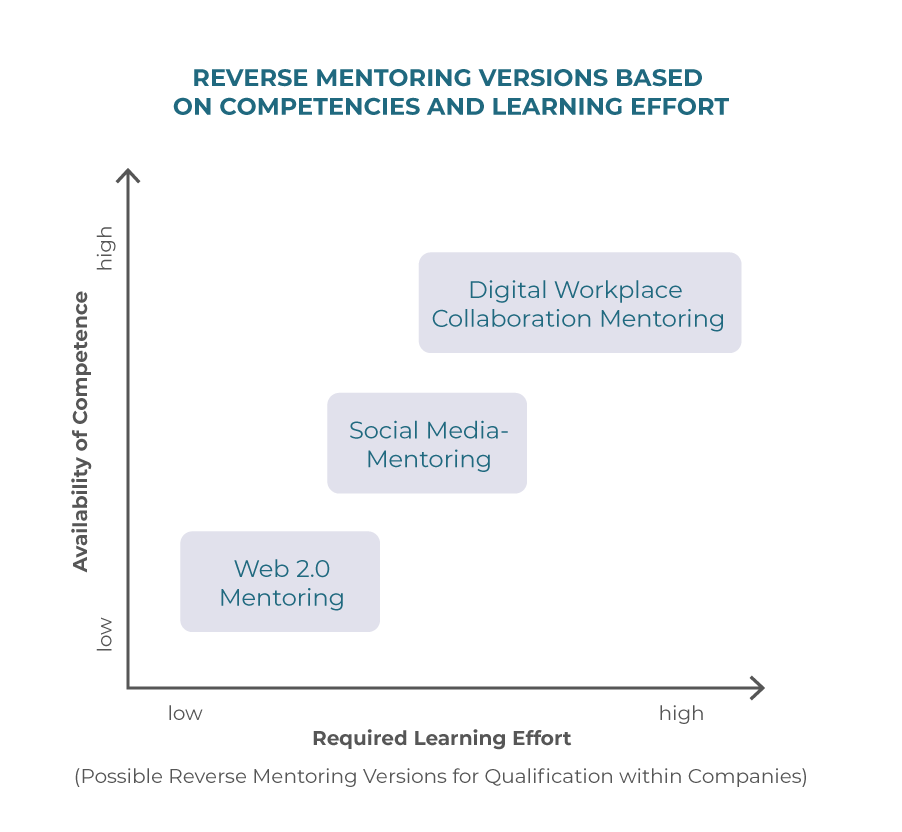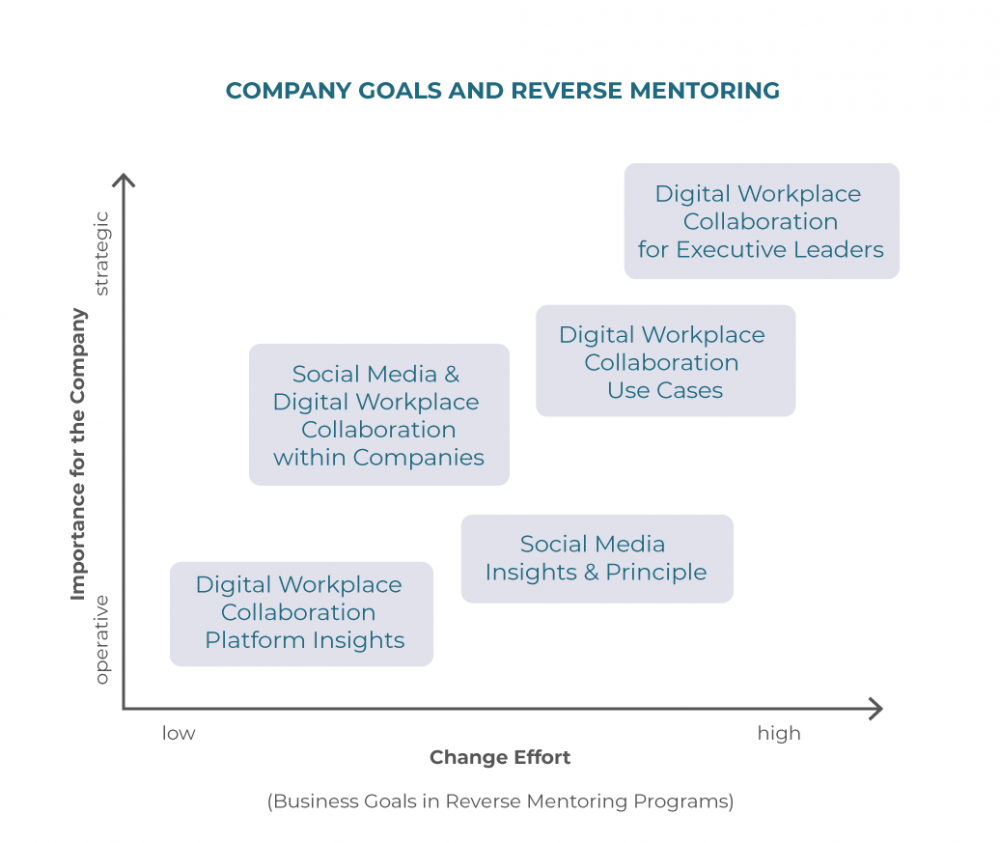REVERSE MENTORING VERSIONS
Following on from my article “101 reverse mentoring – what is it and why do we need it?”, I now want to take a look at how reverse mentoring can help companies implement their specific objectives in the digital age. A key aspect here is to ensure that management staff receive the help and support they need to expand their professional skills and potential with regard to digital workplace collaboration. This includes learning how to increase their influence in the “social sphere” and how to strengthen contacts with clients and partners.
To strike the right balance between available skills and required learning effort (see chart below), individual mentoring programs can be designed with focuses and objectives that vary depending on the level of existing knowledge. At Merck, for example, the mentor role is filled by trainees. As these staff members do not yet have sufficient professional experience, the company opted for a basic Web 2.0 mentoring program. Companies like Bosch, on the other hand, use trained staff who can cover a wide range of topics relating to social media and even provide mentoring on digital workplace collaboration.

POSITIVE IMPACT ON COMPANY GOALS
Reverse mentoring can assist in the implementation of various strategic goals and organizational development targets. In addition, many organizational development topics are so closely linked to a company’s change management processes that they almost always constitute a learning process for the mentee.

Here, the opposing considerations are the “change effort” required on the part of the company and the benefit it gains from this initiative. For the moment, we can map out five thematic blocks with varying learning objectives (see image above). These blocks are further divided into individual, succinct tutorials that the reverse mentoring pairs can use as a starting point in their sessions.
INDIVIDUALLY SCALED LEARNING OBJECTIVES
The content of the program helps the mentees enhance their skills in a variety of ways. The least change effort is required in the introductory operational block Insights into the Digital Workplace Platform. Examples of possible tutorials here include how to create a profile, how to build your own network, or how to find people and information.
Slightly more change effort is required for the insights gained in the Social Media & Digital Workplace block. The focus here is on strategic orientation, with tours of the company’s social media presence and the internal communities of the company’s social networks. Important topics in this area include employer branding and guidelines.
More demanding still is the Social Media Insights & Principles block. The operational orientation here is similar to that of the Digital Workplace Platform block, but the change effort required on the part of the mentees is far greater. They gain a better understanding of the theory behind social media and familiarize themselves with the terminology. They also gain a deeper understanding of blogs and external social networks (Xing, LinkedIn, Kununu, Twitter, Facebook, and YouTube) through practical experience.
The Digital Workplace Collaboration Applications block is even more challenging. The goal here is to demonstrate how to implement new ways of working and, ideally, follow through with actual implementation. It addresses both the strategic and operational use of the new opportunities that enterprise social networks provide. The focus here is on processes such as finding experts, communicating with your own network, and finding, collecting, and combining new ideas and information.
The Digital Workplace Collaboration for Management Staff topic block goes one step further, representing the most demanding reverse mentoring level to date. At this level, the management staff are familiar with the new technology and possibilities and, at best, are able to come up with their own strategic ideas. Examples of tutorials at this level are: “How can I get more involved in social media and digital workplace collaboration?” or “How can I promote the use of the digital workplace in my own area of responsibility?” Various ways of implementing digital workplace collaboration in the company are discussed, as well as topics taken directly from the mentee’s working environment.
PROSPECT – WHAT DO THE PARTICIPANTS SAY?
All these learning processes can be positively influenced by introducing reverse mentoring as a way of supporting change management. In my next post, I will take a look at some feedback from mentees and mentors with regard to the 1:1 learning situation and how it offers flexibility in terms of content and time as well as other beneficial aspects.
About the author
 Milos Vujnovic, who studied technical oriented business economics at the University of Stuttgart, has worked as a social business consultant since 2010. He joined the Berlin-based social business consultancy and technology provider Pokeshot in September 2016, where he leverages his extensive social collaboration and user adoption expertise to consult organizations on how to optimize their change management and enable the usage of social collaboration tools and practices. He is also responsible for setting up and executing reverse mentoring programs for executives, enabling them for digital leadership. He further has deep insights into various studies regarding the current state of social business in general.
Milos Vujnovic, who studied technical oriented business economics at the University of Stuttgart, has worked as a social business consultant since 2010. He joined the Berlin-based social business consultancy and technology provider Pokeshot in September 2016, where he leverages his extensive social collaboration and user adoption expertise to consult organizations on how to optimize their change management and enable the usage of social collaboration tools and practices. He is also responsible for setting up and executing reverse mentoring programs for executives, enabling them for digital leadership. He further has deep insights into various studies regarding the current state of social business in general.
Connect with us on facebook | twitter | LinkedIn | YouTube – we will keep you posted!
1 thought on “Scaling company objectives using graduated reverse mentoring levels”
Comments are closed.